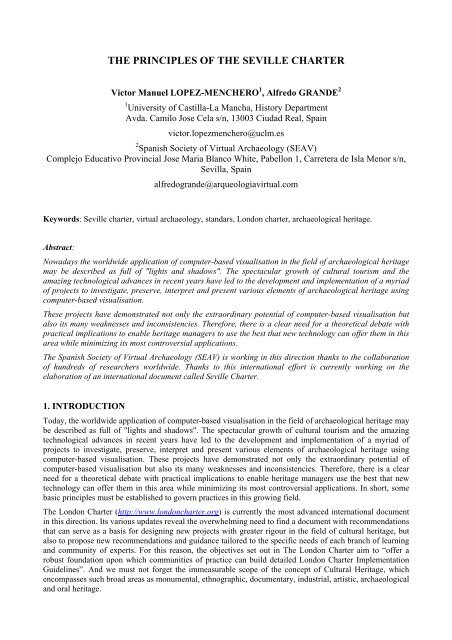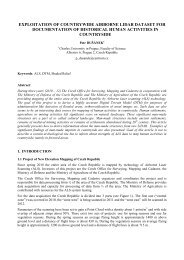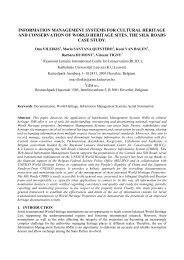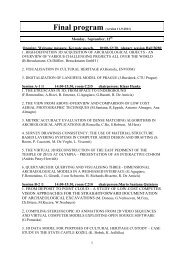THE PRINCIPLES OF THE SEVILLE CHARTER - CIPA - Icomos
THE PRINCIPLES OF THE SEVILLE CHARTER - CIPA - Icomos
THE PRINCIPLES OF THE SEVILLE CHARTER - CIPA - Icomos
Create successful ePaper yourself
Turn your PDF publications into a flip-book with our unique Google optimized e-Paper software.
<strong>THE</strong> <strong>PRINCIPLES</strong> <strong>OF</strong> <strong>THE</strong> <strong>SEVILLE</strong> <strong>CHARTER</strong><br />
Victor Manuel LOPEZ-MENCHERO 1 , Alfredo GRANDE 2<br />
1 University of Castilla-La Mancha, History Department<br />
Avda. Camilo Jose Cela s/n, 13003 Ciudad Real, Spain<br />
victor.lopezmenchero@uclm.es<br />
2 Spanish Society of Virtual Archaeology (SEAV)<br />
Complejo Educativo Provincial Jose Maria Blanco White, Pabellon 1, Carretera de Isla Menor s/n,<br />
Sevilla, Spain<br />
alfredogrande@arqueologiavirtual.com<br />
Keywords: Seville charter, virtual archaeology, standars, London charter, archaeological heritage.<br />
Abstract:<br />
Nowadays the worldwide application of computer-based visualisation in the field of archaeological heritage<br />
may be described as full of "lights and shadows". The spectacular growth of cultural tourism and the<br />
amazing technological advances in recent years have led to the development and implementation of a myriad<br />
of projects to investigate, preserve, interpret and present various elements of archaeological heritage using<br />
computer-based visualisation.<br />
These projects have demonstrated not only the extraordinary potential of computer-based visualisation but<br />
also its many weaknesses and inconsistencies. Therefore, there is a clear need for a theoretical debate with<br />
practical implications to enable heritage managers to use the best that new technology can offer them in this<br />
area while minimizing its most controversial applications.<br />
The Spanish Society of Virtual Archaeology (SEAV) is working in this direction thanks to the collaboration<br />
of hundreds of researchers worldwide. Thanks to this international effort is currently working on the<br />
elaboration of an international document called Seville Charter.<br />
1. INTRODUCTION<br />
Today, the worldwide application of computer-based visualisation in the field of archaeological heritage may<br />
be described as full of "lights and shadows". The spectacular growth of cultural tourism and the amazing<br />
technological advances in recent years have led to the development and implementation of a myriad of<br />
projects to investigate, preserve, interpret and present various elements of archaeological heritage using<br />
computer-based visualisation. These projects have demonstrated not only the extraordinary potential of<br />
computer-based visualisation but also its many weaknesses and inconsistencies. Therefore, there is a clear<br />
need for a theoretical debate with practical implications to enable heritage managers use the best that new<br />
technology can offer them in this area while minimizing its most controversial applications. In short, some<br />
basic principles must be established to govern practices in this growing field.<br />
The London Charter (http://www.londoncharter.org) is currently the most advanced international document<br />
in this direction. Its various updates reveal the overwhelming need to find a document with recommendations<br />
that can serve as a basis for designing new projects with greater rigour in the field of cultural heritage, but<br />
also to propose new recommendations and guidance tailored to the specific needs of each branch of learning<br />
and community of experts. For this reason, the objectives set out in The London Charter aim to “offer a<br />
robust foundation upon which communities of practice can build detailed London Charter Implementation<br />
Guidelines”. And we must not forget the immeasurable scope of the concept of Cultural Heritage, which<br />
encompasses such broad areas as monumental, ethnographic, documentary, industrial, artistic, archaeological<br />
and oral heritage.
The London Charter takes full account of the Cultural Heritage as a concept, and therefore the specific needs<br />
required by each of its constituent parts. For this reason, the Preamble to the London Charter recognises<br />
these needs: “as the aims that motivate the use of visualisation methods vary widely from domain to domain,<br />
Principle 1: “Implementation”, signals the importance of devising detailed guidelines appropriate to each<br />
community of practice”. Principle 1.1 recommends: “Each community of practice, whether academic,<br />
educational, curatorial or commercial, should develop London Charter Implementation Guidelines that<br />
cohere with its own aims, objectives and methods”. It therefore seems obvious that, given the importance of<br />
archaeological heritage as part of cultural heritage, and since many recognise the existence of a community<br />
of experts who focus specifically on the concept of Virtual Archaeology, consideration must be given to the<br />
preparation of guidelines, documents and recommendations that even following the general guidelines<br />
established by the London Charter, take into account the specific nature of Virtual Archaeology.<br />
The principles discussed below aim to increase the conditions of applicability of the London Charter in order<br />
to improve its implementation specifically in the field of archaeological heritage, including industrial<br />
archaeological heritage, simplifying and organising its bases sequentially, while at the same time offering<br />
new recommendations taking into account the specific nature of archaeological heritage in relation to<br />
cultural heritage.<br />
2. DEFINITIONS<br />
Virtual archaeology: the scientific discipline that seeks to research and develop ways of using computerbased<br />
visualisation for the comprehensive management of archaeological heritage.<br />
Archaeological heritage: the set of tangible assets, both movable and immovable, irrespective of whether<br />
they have been extracted or not and whether they are on the surface or underground, on land or in water,<br />
which together with their context, which will also be considered a part of archaeological heritage, serve as a<br />
historical source of knowledge on the history of humankind. The distinguishing feature of these elements,<br />
which were or have been abandoned by the cultures that produced them, is that they may be studied,<br />
recovered or located using archaeological methodology as the primary method of research, using mainly<br />
excavation and surveying or prospection techniques, without compromising the possibility of using other<br />
complementary methods for knowledge.<br />
Comprehensive management: this includes inventories, surveys, excavation work, documentation,<br />
research, maintenance, conservation, preservation, restoration, interpretation, presentation, access and public<br />
use of the material remains of the past.<br />
Virtual restoration: this involves using a virtual model to reorder available material remains in order to<br />
visually recreate something that existed in the past. Thus, virtual restoration includes virtual anastylosis.<br />
Virtual anastylosis: this involves restructuring existing but dismembered parts in a virtual model.<br />
Virtual reconstruction: this involves using a virtual model to visually recover a building or object made by<br />
humans at a given moment in the past from available physical evidence of these buildings or objects,<br />
scientifically-reasonable comparative inferences and in general all studies carried out by archaeologists and<br />
other experts in relation to archaeological and historical science.<br />
Virtual recreation: this involves using a virtual model to visually recover an archaeological site at a given<br />
moment in the past, including material culture (movable and immovable heritage), environment, landscape,<br />
customs, and general cultural significance.<br />
3. OBJECTIVES<br />
Since the theoretical framework for the Seville Charter is the London Charter, this document would adopt all<br />
the objectives approved by the Advisory Board of the London Charter. These general objectives should be<br />
accompanied by some new objectives, namely:<br />
- Generate easily understandable and applicable criteria for the whole community of experts, including<br />
indistinctly computer experts, archaeologists, architects, engineers, general managers or specialists in the<br />
field.
- Establish guidelines aimed at giving the public a greater understanding and better appreciation of the<br />
ongoing work of archaeology.<br />
- Establish principles and criteria for measuring the quality of projects carried out in the field of virtual<br />
archaeology.<br />
- Promote the responsible use of new technologies for the comprehensive management of archaeological<br />
heritage.<br />
- Help improve current archaeological heritage research, conservation and dissemination processes using<br />
new technologies.<br />
- Open new doors for the application of digital methods and techniques in archaeological research,<br />
conservation and dissemination.<br />
- Raise awareness of the international scientific community of the prevailing need to make concerted efforts<br />
worldwide in the growing field of virtual archaeology.<br />
4. <strong>PRINCIPLES</strong><br />
4.1. Principle 1: Interdisciplinarity<br />
Any project involving the use of new technologies, linked to computer-based visualisation in the field of<br />
archaeological heritage, whether for research, conservation or dissemination must be supported by a team of<br />
professionals from different branches of knowledge.<br />
4.1.1 Given the complex nature of computer-based visualisation of archaeological heritage, it can not be<br />
addressed only by a single type of expert but needs the cooperation and complicity of a large number of<br />
specialists (archaeologists, computer scientists, historians, architects, engineers etc.).<br />
4.1.2 A truly interdisciplinary work involves the regular and fluid exchange of ideas and views among<br />
specialists from different fields. Work divided into watertight compartments can never be considered<br />
interdisciplinary even with the participation of experts from different disciplines.<br />
4.1.3 Among the experts who must collaborate in this interdisciplinary model, it is essential to ensure the<br />
specific presence of archaeologists, preferably those who are or were responsible for the scientific<br />
management of the excavation work or archaeological remains to be reconstructed.<br />
4.2. Principle 2: Purpose<br />
Prior to the development of any computer-based visualisation, the ultimate purpose or goal of our work must<br />
always be completely clear.<br />
4.2.1 Any proposed computer-based visualisation will always aim to improve aspects related to the research,<br />
conservation or dissemination of archaeological heritage. The overall aim of the project must be<br />
encompassed within one of these categories (research, conservation and/or dissemination).<br />
4.2.2 In addition to clarifying the main purpose of computer-based visualisation, more specific objectives<br />
must always be defined in order to obtain more precise knowledge of the problem or problems to be<br />
resolved.<br />
4.2.3 Computer-based visualisation must be always at the service of archaeological heritage rather than<br />
archaeological heritage being at the service of computer-based visualisation. The main objective of<br />
applying new technologies in the comprehensive management of archaeological heritage must be to<br />
satisfy the real needs of archaeologists, curators, restorers, museographers, managers and/or other<br />
professionals in the field of heritage and not vice-versa.
4.3. Principle 3: Complementarity<br />
The application of computer-based visualisation for the comprehensive management of archaeological<br />
heritage must be treated as a complementary and not alternative tool to other more traditional but equally<br />
effective management instruments.<br />
4.3.1 Computer-based visualisation should not aspire to replace other methods and techniques employed for<br />
the comprehensive management of archaeological heritage (e.g. virtual restoration should not aspire to<br />
replace real restoration, just as virtual visits should not aspire to replace real visits).<br />
4.3.2 Computer-based visualisation should seek forms of collaboration with other methods and techniques of<br />
a different nature to help improve current archaeological heritage research, conservation and<br />
dissemination processes. To do so, compliance with “Principle 1: Interdisciplinarity” will be<br />
fundamental.<br />
4.3.3. Nevertheless, computer-based visualisations may have be an alternative when original archaeological<br />
remains have been destroyed (e.g. due to the construction of large infrastructures), are in places that are<br />
difficult to access (e.g. when there are no roads) or at risk of deterioration due to the huge influx of<br />
tourists (e.g. rock paintings).<br />
4.4. Principle 4: Authenticity<br />
Computer-based visualisation normally reconstructs or recreates historical buildings and environments as we<br />
believe them to have been in the past. For that reason, it should always be possible to distinguish what is real,<br />
genuine or authentic from what is not. In this sense, authenticity must be a permanent operational concept in<br />
any virtual archaeology project.<br />
4.4.1 Since archaeology is complex and not an exact and irrefutable science, it must be openly committed to<br />
making alternative virtual interpretations provided they afford the same scientific validity. When that<br />
equality does not exist, only the main hypothesis will be endorsed.<br />
4.4.2 When performing virtual restorations or reconstructions, these must explicitly or through additional<br />
interpretations show the different levels of accuracy on which the restoration or reconstruction is based.<br />
4.4.3 In so far as many archaeological remains have been and are being restored or reconstructed, computerbased<br />
visualisation should really help both professionals and the public to differentiate clearly between:<br />
remains that have been conserved “in situ”; remains that have been returned to their original position<br />
(real anastylosis); areas that have been partially or completely rebuilt on original remains; and finally,<br />
areas that have been restored or reconstructed virtually.<br />
4.5. Principle 5: Historical rigour.<br />
To achieve optimum levels of historical rigour and veracity, any form of computer-based visualisation of the<br />
past must be supported by solid research and historical and archaeological documentation.<br />
4.5.1 The historical rigour of any computer-based visualisation of the past will depend on both the rigour<br />
with which prior archaeological research has been performed and the rigour with which that information<br />
is used to create the virtual model.<br />
4.5.2 All historical phases recorded during archaeological research are extremely valuable. Thus, a rigorous<br />
approach would not be one that shows only the time of splendour of reconstructed or recreated<br />
archaeological remains but rather one that shows all the phases, including periods of decline. Nor should<br />
it display an idyllic image of the past with seemingly newly-constructed buildings, people who look like<br />
models, etc., but rather a real image, i.e. with buildings in varying states of conservation, people of<br />
different sizes and weights, etc.<br />
4.5.3 The environment, landscape or context associated with archaeological remains is as important as the<br />
ruin itself (Charter of Krakow, 2000). Charcoal, paleobotanical, paleozoological and physical<br />
paleoanthropological research must serve as a basis for conducting rigorous virtual recreations of
landscape and context. They cannot systematically show lifeless cities, lonely buildings or dead<br />
landscapes, because this is an historical falsehood.<br />
4.6. Principle 6: Efficiency<br />
The concept of efficiency applied to the field of virtual archaeology depends inexorably on achieving<br />
appropriate economic and technological sustainability. Using fewer resources to achieve increasingly more<br />
and better results is the key to efficiency.<br />
4.6.1 Any project that involves the use of computer-based visualisation in the field of archaeological heritage<br />
must pre-screen the economic and technological maintenance needs that it will generate once installed<br />
and operative.<br />
4.6.2 Priority must be given to systems that may initially require high investments but in the long term have<br />
low economic maintenance cost and offer high reliability, i.e. low-consumption systems that are<br />
resistant, easy to repair or modify.<br />
4.6.3 Whenever possible, draw on the results obtained by previous visualisation projects, avoiding duplicity,<br />
i.e. performing the same work twice.<br />
4.7. Principle 7: Scientific transparency<br />
All computer-based visualisation must be essentially transparent, i.e. testable by other researchers or<br />
professionals, since the validity, and therefore the scope, of the conclusions produced by such visualisation<br />
will depend largely on the ability of others to confirm or refute the results obtained.<br />
4.7.1 It is clear that all computer-based visualisation involves a large amount of scientific research.<br />
Consequently, for the virtual archaeology projects to achieve scientific and academic rigour it is essential<br />
to prepare documentary bases in which to gather and present the entire work process in a completely<br />
transparent fashion: objectives, methodology, techniques, reasoning, origin and characteristics of the<br />
sources of research, results and conclusions.<br />
4.7.2 In any case, and in general, the registration and organisation of all documentation relating to virtual<br />
archaeological projects will be based on the "Principles for the recording of monuments, groups of<br />
buildings and sites" ratified by the 11th ICOMOS General Assembly in 1996.<br />
4.7.3 In the interests of scientific transparency, it is necessary to create a large globally-accessible database<br />
with projects that offer optimum levels of quality (Art 8.4), without undermining the creation of national<br />
or regional databases of this type.<br />
4.8. Principle 8: Training and evaluation<br />
Virtual archaeology is a scientific discipline related to the comprehensive management of archaeological<br />
heritage that has its own specific language and techniques. Like any other academic discipline, it requires<br />
specific training and evaluation programmes.<br />
4.8.1 High-level postgraduate training programmes must be promoted to strengthen the training and<br />
specialisation of a sufficient number of qualified professionals in this field.<br />
4.8.2 When computer-based visualisations are designed as instruments for the enjoyment and knowledge of<br />
the general public, the most appropriate method of evaluation will be visitors’ studies.<br />
4.8.3 When computer-based visualisations are intended to serve as an instrument for archaeological research<br />
and conservation, the most appropriate archaeological evaluation method will be testing by a sufficiently<br />
representative number of end users, i.e. professionals for whom the final product is intended.<br />
4.8.4 The final quality of any computer-based visualisation must be measured by the rigour with which it has<br />
been developed and not the spectacularity of its results. Compliance with all the principles emanating<br />
from this Charter will determine whether the end result of a computer-based visualisation can be<br />
considered “top quality”.






